英语人教版八年级上册复习一般过去时
- 格式:doc
- 大小:39.50 KB
- 文档页数:6
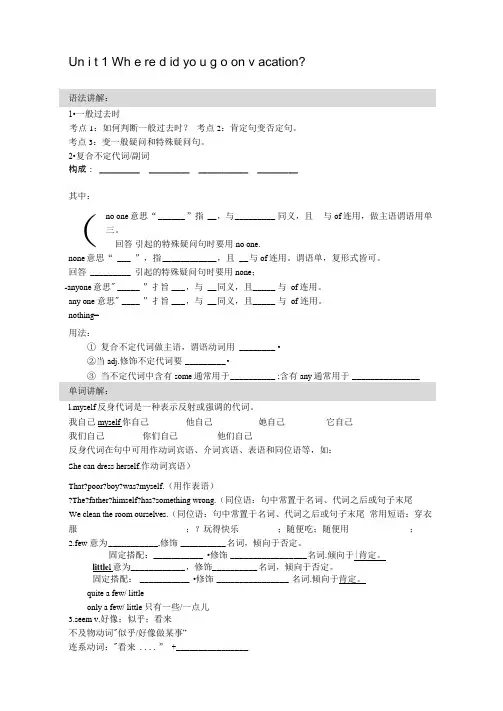
Un i t 1 Wh e re d id yo u g o on v acation?1•一般过去时考点1:如何判断一般过去时?考点2:肯定句变否定句。
考点3:变一般疑问和特殊疑问句。
2•复合不定代词/副词构成: _________ _________ ___________ _________其中:(no one意思“______ ”指 __ ,与_________ 同义,且与of连用,做主语谓语用单三。
回答引起的特殊疑问句时要用no one.none意思“ ___ ”,指____________ ,且 __ 与of连用。
谓语单,复形式皆可。
回答 _________ 引起的特殊疑问句时要用none;-anyone意思" _____ ”扌旨___ ,与 __ 同义,且_____ 与of连用。
_any one 意思" ____ ”扌旨___ ,与 __ 同义,且_____ 与of 连用。
nothing= _________________用法:① 复合不定代词做主语,谓语动词用 ________ •②当adj.修饰不定代词要_________ •③ 当不定代词中含有some通常用于__________ ;含有any通常用于_______________我自己myself你自己他自己她自己它自己我们自己你们自己他们自己反身代词在句中可用作动词宾语、介词宾语、表语和同位语等,如:She can dress herself.作动词宾语)That?poor?boy?was?myself.(用作表语)Thefatherhimselfhassomething wrong.(同位语:句中常置于名词、代词之后或句子末尾We clean the room ourselves.(同位语:句中常置于名词、代词之后或句子末尾常用短语:穿衣服;?玩得快乐;随便吃;随便用;2.few 意为___________,修饰__________ 名词,倾向于否定。
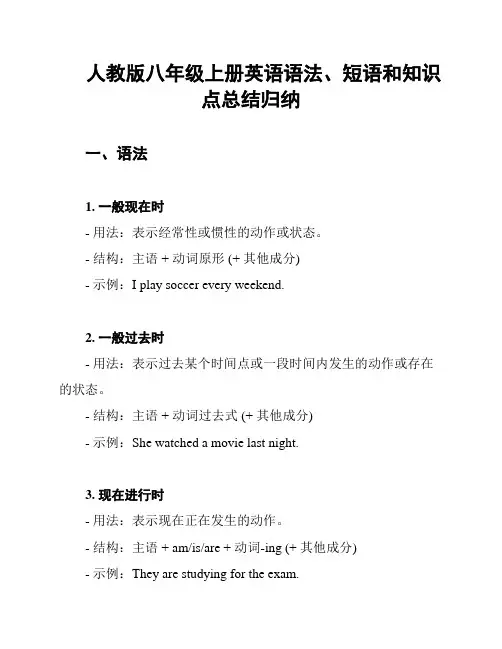
人教版八年级上册英语语法、短语和知识点总结归纳一、语法1. 一般现在时- 用法:表示经常性或惯性的动作或状态。
- 结构:主语 + 动词原形 (+ 其他成分)- 示例:I play soccer every weekend.2. 一般过去时- 用法:表示过去某个时间点或一段时间内发生的动作或存在的状态。
- 结构:主语 + 动词过去式 (+ 其他成分)- 示例:She watched a movie last night.3. 现在进行时- 用法:表示现在正在发生的动作。
- 结构:主语 + am/is/are + 动词-ing (+ 其他成分)- 示例:They are studying for the exam.4. 现在完成时- 用法:表示动作或状态发生在过去某个时间点,但与现在有关。
- 结构:主语 + have/has + 动词过去分词 (+ 其他成分)- 示例:I have finished my homework.5. 情态动词- 用法:表示能力、意愿、可能性等。
- 常见的情态动词有 can, could, may, might, must, should, ought to 等。
- 示例:He should go to bed early.二、短语1. as well as- 用法:表示两个事物同时存在或发生。
- 示例:She can speak English as well as Chinese.2. in order to- 用法:为了做某事。
- 示例:They woke up early in order to catch the train.3. by the way- 用法:用于引入一个新的话题或问题。
- 示例:By the way, have you seen the latest movie?三、知识点1. 直接引语和间接引语- 直接引语:用引号括起来的原话。
- 间接引语:将直接引语转述为陈述句或疑问句。
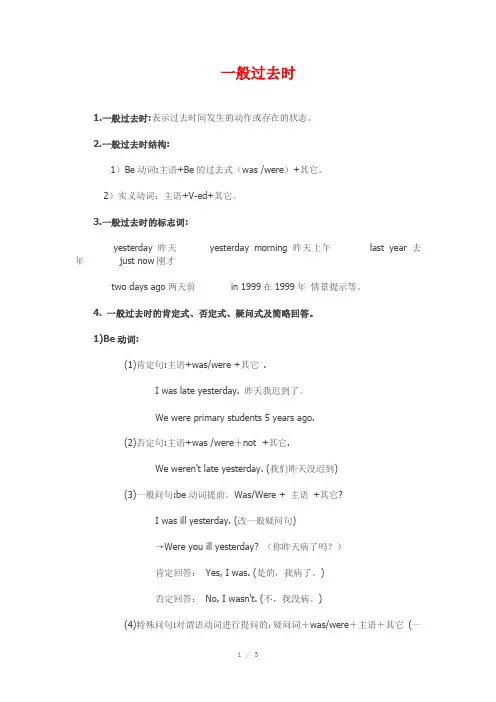
一般过去时1.一般过去时:表示过去时间发生的动作或存在的状态。
2.一般过去时结构:1)Be动词:主语+Be的过去式(was /were)+其它。
2)实义动词:主语+V-ed+其它。
3.一般过去时的标志词:yesterday昨天 yesterday morning 昨天上午 last year去年just now刚才two days ago两天前in 1999在1999年情景提示等。
4. 一般过去时的肯定式、否定式、疑问式及简略回答。
1)Be动词:(1)肯定句:主语+was/were +其它 .I was late yesterday. 昨天我迟到了。
We were primary students 5 years ago.(2)否定句:主语+was /were+not +其它.We weren't late yesterday. (我们昨天没迟到)(3)一般问句:be动词提前。
Was/Were + 主语+其它?I was ill yesterday. (改一般疑问句)→Were you ill yesterday? (你昨天病了吗?)肯定回答:Yes, I was. (是的,我病了。
)否定回答:No, I wasn't. (不,我没病。
)(4)特殊问句:对谓语动词进行提问的:疑问词+was/were+主语+其它(一般疑问句)?I was born in 1997.→When were you born? 你是什么时候出生的?2)实义动词:(1)肯定句:主语+V-ed +其它。
I called up my good friend just now.(2)否定句: 主语+didn’t +V原形+其它I didn’t argue w ith Tom last week.(3)一般问疑句:Did +主语+ V原形+其它?I bought a souvenir in 2010. (改一般疑问句)→Did you buy a souvenir in 2010?肯定回答:Yes, I did.否定回答:No, I didn’t.(4)特殊疑问句: 疑问词+did +主语+ V原形+其它?I went to HongKong last year.→Where did you go to HongKong last year?5. 变化规则(1)、规则动词的变化规则:(1)一般情况下在词尾直接加ed。
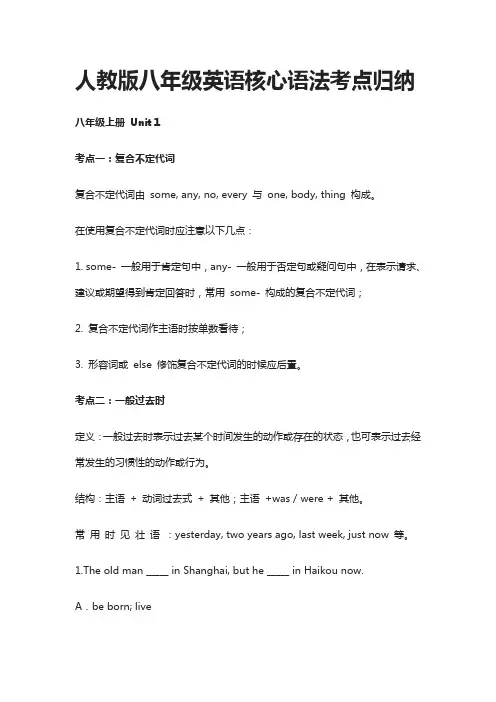
人教版八年级英语核心语法考点归纳八年级上册Unit 1考点一:复合不定代词复合不定代词由some, any, no, every 与one, body, thing 构成。
在使用复合不定代词时应注意以下几点:1. some- 一般用于肯定句中,any- 一般用于否定句或疑问句中,在表示请求、建议或期望得到肯定回答时,常用some- 构成的复合不定代词;2. 复合不定代词作主语时按单数看待;3. 形容词或else 修饰复合不定代词的时候应后置。
考点二:一般过去时定义:一般过去时表示过去某个时间发生的动作或存在的状态,也可表示过去经常发生的习惯性的动作或行为。
结构:主语+ 动词过去式+ 其他;主语+was / were + 其他。
常用时见壮语:yesterday, two years ago, last week, just now 等。
1.The old man _____ in Shanghai, but he _____ in Haikou now.A.be born; liveB.was born ; liveC.is born; livesD.was born; lives2. —Where were you last Saturday?—I ____ in the Capital Museum.A. amB. will beC. wasD. have been八年级上册Unit 2考点一:拼读副词频度副词表示动作或行为发生的频率。
常见的频度副词及其发生的频率如下表:考点二:how 疑问词组练一练3.()do you usually go to school,Simon? -by bike.A.WhenB.HowC.WhatD.Where(答案在文末获取)八年级上册Unit 3考点一:形容词和副词的比较级形容词和副词的比较能表示两者之间的比较关系,表示A 比B 更……,通常用than 来连接。
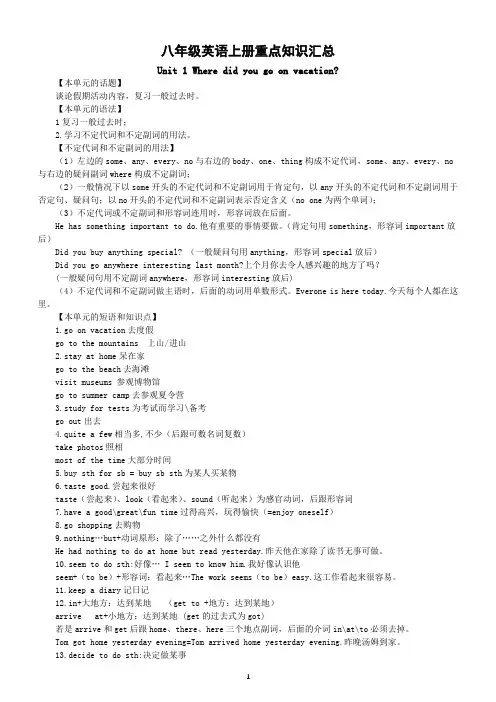
八年级英语上册重点知识汇总Unit 1 Where did you go on vacation?【本单元的话题】谈论假期活动内容,复习一般过去时。
【本单元的语法】1复习一般过去时;2.学习不定代词和不定副词的用法。
【不定代词和不定副词的用法】(1)左边的some、any、every、no与右边的body、one、thing构成不定代词,some、any、every、no 与右边的疑问副词where构成不定副词;(2)一般情况下以some开头的不定代词和不定副词用于肯定句,以any开头的不定代词和不定副词用于否定句、疑问句;以no开头的不定代词和不定副词表示否定含义(no one为两个单词);(3)不定代词或不定副词和形容词连用时,形容词放在后面。
He has something important to do.他有重要的事情要做。
(肯定句用something,形容词important放后)Did you buy anything special? (一般疑问句用anything,形容词special放后)Did you go anywhere interesting last month?上个月你去令人感兴趣的地方了吗?(一般疑问句用不定副词anywhere,形容词interesting放后)(4)不定代词和不定副词做主语时,后面的动词用单数形式。
Everone is here today.今天每个人都在这里。
【本单元的短语和知识点】1.go on vacation去度假go to the mountains 上山/进山2.stay at home呆在家go to the beach去海滩visit museums 参观博物馆go to summer camp去参观夏令营3.study for tests为考试而学习\备考go out出去4.quite a few相当多,不少(后跟可数名词复数)take photos照相most of the time大部分时间5.buy sth for sb = buy sb sth为某人买某物6.taste good.尝起来很好taste(尝起来)、look(看起来)、sound(听起来)为感官动词,后跟形容词7.have a good\great\fun time过得高兴,玩得愉快(=enjoy oneself)8.go shopping去购物9.nothing…but+动词原形:除了……之外什么都没有He had nothing to do at home but read yesterday.昨天他在家除了读书无事可做。
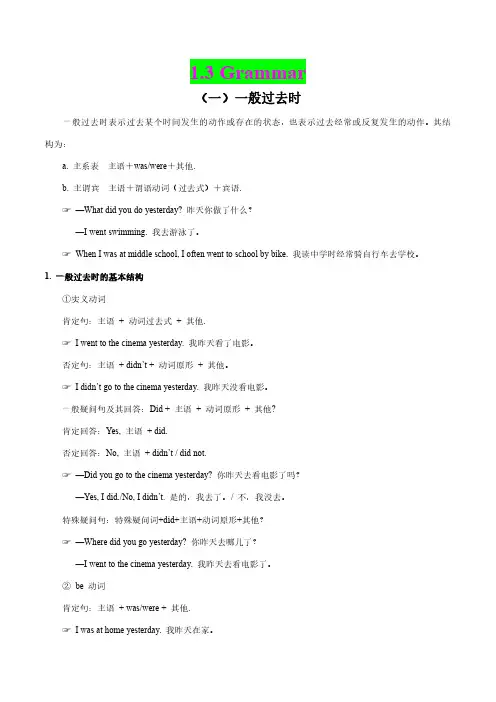
1.3Grammar(一)一般过去时一般过去时表示过去某个时间发生的动作或存在的状态,也表示过去经常或反复发生的动作。
其结构为:a.主系表主语+was/were+其他.b.主谓宾主语+谓语动词(过去式)+宾语.☞—What did you do yesterday?昨天你做了什么?—I went swimming.我去游泳了。
☞When I was at middle school,I often went to school by bike.我读中学时经常骑自行车去学校。
1.一般过去时的基本结构①实义动词肯定句:主语+动词过去式+其他.☞I went to the cinema yesterday.我昨天看了电影。
否定句:主语+didn’t+动词原形+其他。
☞I didn’t go to the cinema yesterday.我昨天没看电影。
一般疑问句及其回答:Did+主语+动词原形+其他?肯定回答:Yes,主语+did.否定回答:No,主语+didn’t/did not.☞—Did you go to the cinema yesterday?你昨天去看电影了吗?—Yes,I did./No,I didn’t.是的,我去了。
/不,我没去。
特殊疑问句:特殊疑问词+did+主语+动词原形+其他?☞—Where did you go yesterday?你昨天去哪儿了?—I went to the cinema yesterday.我昨天去看电影了。
②be动词肯定句:主语+was/were+其他.☞I was at home yesterday.我昨天在家。
否定句:主语+wasn’t/weren’t+其他.☞I wasn’t at home yesterday.我昨天没在家。
一般疑问句及其回答:Were/Was+主语+其他?☞—Were you at home yesterday?你昨天在家吗?—Yes,I was./No,I wasn’t.是的,我在家。
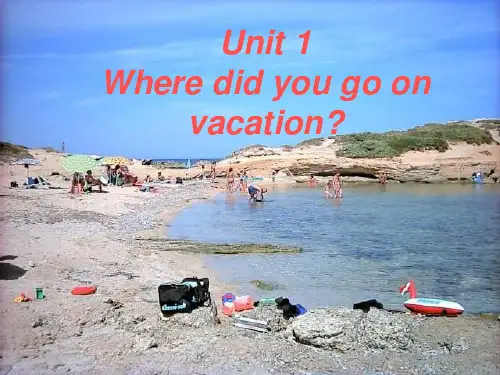
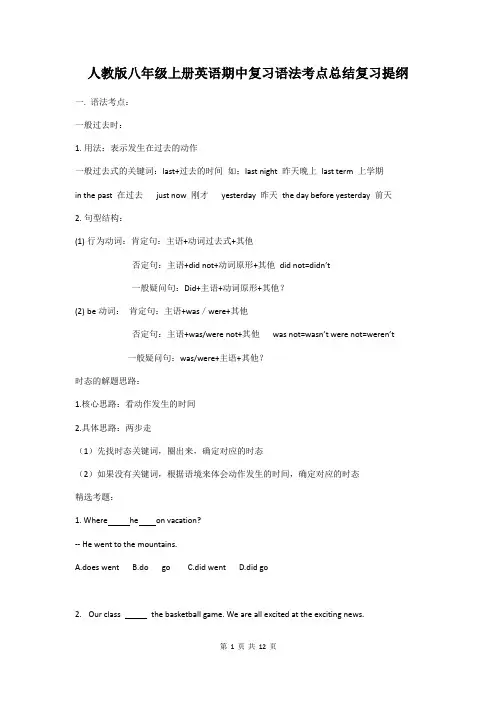
人教版八年级上册英语期中复习语法考点总结复习提纲一. 语法考点:一般过去时:1.用法:表示发生在过去的动作一般过去式的关键词:last+过去的时间如:last night 昨天晚上last term 上学期in the past 在过去just now 刚才yesterday 昨天the day before yesterday 前天2.句型结构:(1)行为动词:肯定句:主语+动词过去式+其他否定句:主语+did not+动词原形+其他did not=didn’t一般疑问句:Did+主语+动词原形+其他?(2)be动词:肯定句:主语+was/were+其他否定句:主语+was/were not+其他was not=wasn’t were not=weren’t一般疑问句:was/were+主语+其他?时态的解题思路:1.核心思路:看动作发生的时间2.具体思路:两步走(1)先找时态关键词,圈出来,确定对应的时态(2)如果没有关键词,根据语境来体会动作发生的时间,确定对应的时态精选考题:1. Where he on vacation?-- He went to the mountains.A.does wentB.do goC.did wentD.did go2.Our class the basketball game. We are all excited at the exciting news.A.will winB. winsC.wonD.is winning3. --Where you last night?-- I at home.A.are;amB.am;amC.were,wasD.were;were4. you visit your grandma last Friday?---No, I .A.Do;Study at homeB.Did; visited my grandmaC. Does; went swimmingD.Did; stayed at home5. Did you visit your grandma last Friday?---No, I .B.Study at home B.visited my grandmaC. Went swimmingD.stay at home6. He visited (visit) his grandparents last week.7. They took (take) quite a few photos (photo) when they visited Mount Tai.8. Kevin (go) (somewhere) interesting last month.9. Mrs Black (pick) some flowers in the garden yesterday.10. The old man (take) many photos and put them into his bag.put--put read--read cost--cost run---ran win--wontake--took buy---bought bring--brought play--played teach--taught1.Everyone had a good time there. (改为一般疑问句及否定句)have--过去式had。
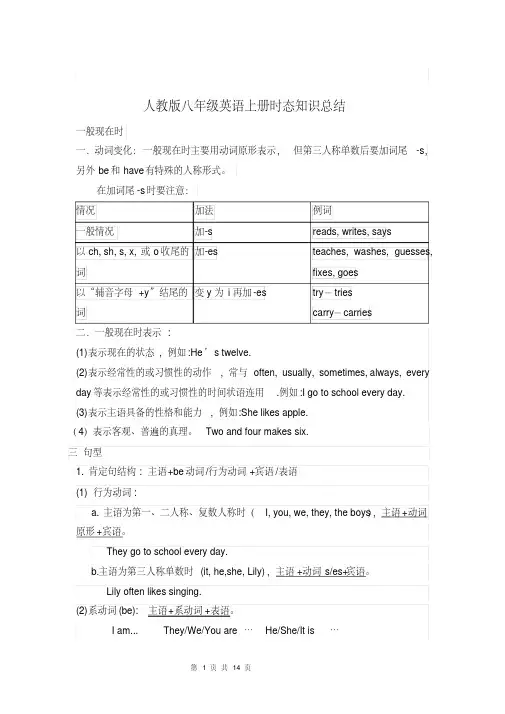
人教版八年级英语上册时态知识总结一般现在时一.动词变化:一般现在时主要用动词原形表示,但第三人称单数后要加词尾-s,另外be和have有特殊的人称形式。
在加词尾-s时要注意:情况加法例词一般情况加-s reads, writes, says以ch, sh, s, x, 或o收尾的词加-es teaches, washes, guesses,fixes, goes以“辅音字母+y”结尾的词变y为i再加-es try-triescarry-carries二.一般现在时表示:(1)表示现在的状态, 例如:He’s twelve.(2)表示经常性的或习惯性的动作, 常与often, usually, sometimes, always, every day等表示经常性的或习惯性的时间状语连用.例如:I go to school every day. (3)表示主语具备的性格和能力, 例如:She likes apple.(4)表示客观、普遍的真理。
Two and four makes six.三句型1. 肯定句结构: 主语+be动词/行为动词+宾语/表语(1) 行为动词:a. 主语为第一、二人称、复数人称时(I, you, we, they, the boys),主语+动词原形+宾语。
They go to school every day.b.主语为第三人称单数时(it, he,she, Lily),主语+动词s/es+宾语。
Lily often likes singing.(2)系动词(be): 主语+系动词+表语。
I am... They/We/You are… He/She/It is…2.否定句结构: 主语+be动词/行为动词+宾语/表语(1) 行为动词:a. 主语为第一、二人称,复数人称时,主语+don’t+动词原形。
They don’t go to school every day.b.主语为第三人称单数时,主语+doesn’t +动词原形。
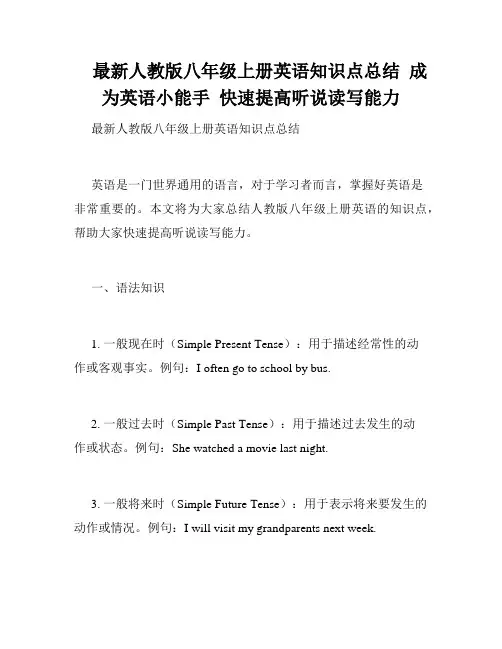
最新人教版八年级上册英语知识点总结成为英语小能手快速提高听说读写能力最新人教版八年级上册英语知识点总结英语是一门世界通用的语言,对于学习者而言,掌握好英语是非常重要的。
本文将为大家总结人教版八年级上册英语的知识点,帮助大家快速提高听说读写能力。
一、语法知识1. 一般现在时(Simple Present Tense):用于描述经常性的动作或客观事实。
例句:I often go to school by bus.2. 一般过去时(Simple Past Tense):用于描述过去发生的动作或状态。
例句:She watched a movie last night.3. 一般将来时(Simple Future Tense):用于表示将来要发生的动作或情况。
例句:I will visit my grandparents next week.4. 现在进行时(Present Continuous Tense):用于表示现在正在进行的动作。
例句:They are playing football in the park.5. 现在完成时(Present Perfect Tense):用于表示过去发生但与现在有关的动作。
例句:We have lived here for five years.6. 情态动词(Modal Verbs):用于表示能力、允许、必须、愿意等情态。
例句:You should finish your homework on time.7. 被动语态(Passive Voice):用于强调动作的承受者而不是执行者。
例句:The book was written by a famous author.二、词汇积累1. 常用动词(Verbs):如read、write、speak等。
2. 日常生活词汇(Daily Life Vocabulary):如food、clothes、weather等。
3. 时间词汇(Time Vocabulary):如Monday、morning、year 等。
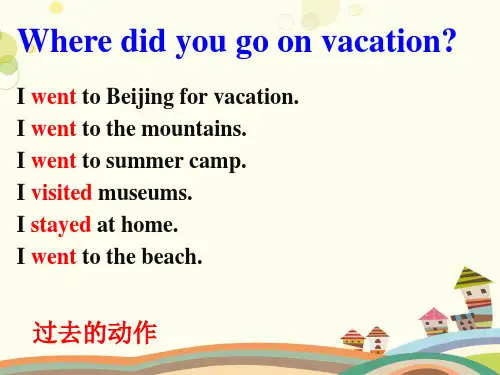
第一单元重点语法【一般过去时】1.概念:表示过去某个时间里发生的动作或状态;过去习惯性、经常性的动作、行为;过去主语所具备的能力和性格。
2.时间标志词1. yesterday, the day before yesterday2. 时间段+ago: three years ago, long ago…3. last: last day/ week/ year…4. in+过去年份: in 2015…5. just now 刚才【复合不定代词】复合不定代词是由some-,any-,no-,every-加上-one,-body,-thing等所组成的不定代词。
例如:Everyone wants to win.考向二:复合不定代词被形容词修饰,形容词后置例如:I have something interesting to tell you.考点三:辨析something/someone/somebody,anything/anyone/anybody,nothing/noone/nobody,everything/everyone/everybody1.something,someone,somebody通常用于肯定句中2.anything,anyone,anybody一般用于否定句、疑问句或条件状语从句中。
3. not....anything = nothing注意:1)在表示请求、邀请、提建议等带有委婉语气的疑问句,和希望得到对方肯定答复的疑问句,以及表示反问的问句中,也用something,someone,somebody等复合不定代词。
如:Would you like something to eat?2)当anything表示“任何事(物),无论何事(物)”,anyone,anybody表示“无论谁,任何人”等意义时,它们也可以用于肯定句中。
如:Anybody knows the answer.任何人都知道答案。
八年级上册重要知识点Unit1Where did you go on vacation?1.一般过去时(动词过去式规则变化)2.enough作形容词,足够的,修饰名词时,置于名词前;作副词,足够,放在形容词、副词后。
如:Mr.Smith has enough money,but he isn’t kind enough to help others.3.else作形容词,修饰疑问代词和不定代词后置如:what else,who else,something else4.复合不定代词的用法5.【延伸】one of+the most+adj+n复数,表示“最…之一”如:He is one of the most famous writers in China.a most+adj+n非常如:Hangzhou is a most beautiful city.6.反身代词①Did you buy anything for yourself?(做介词宾语)②The old man taught himself English.(做动词宾语)③The cow was itself again.又恢复了原状(做表语)④I myself visited my aunt last weekend.(做同位语)7.8.another two hours=two more hours9.感叹句①How+形容词+主语+谓语!②What a/an+形容词+可数名词单数+主语+谓语!What+形容词+复数名词/不可数名词+主语+谓语!10.so that引导目的状语从句,以便,为了(in order to)如:they got up early so that they could catch the bus.so+adj+that+结果状语从句,“如此……以致……”如:I was so busy that I didn’t go to sleep for3days.so+adj+(a/an+n单数)that如:It is so important a meeting that I can’t miss it.such+a/an+adj+n单数+that如:It is such an important meeting that I can’t miss it.such+adj+n复数/不可数+thatUnit2How often do you exercise?1.how如何(方式)how long多长(时间)答语常用“For+时间段”how far多远(距离)答语常用“It’s+数词+miles/meters/kilometers”how often多久一次(频率)答语常用“Always/often/every day/…”或“次数+时间”等表频率的状语how soon多快,多久以后,常用在将来时中。
八上unit1 Where didi you go on vacation重点精讲重点语法精讲一、一般过去时1.动词过去式的拼写规则1).动词过去式规则变化:2).动词过去式的不规则变化:2.一般过去时结构:do 肯定句否定句一般疑问句1)肯定句:“主语+动词的过去式+其他.”I helped him to carry the heavy box last week.我上周帮他搬了这个重盒子2)否定句:“主语+did not (didn't)+动词原形+其他.”I did not (didn't) walk to school today.我今天没有走路上学。
3)一般疑问句:“Did+主语+动词原形+其他?”肯定回答:“Yes, 主语+did.”否定回答:“No, 主语+didn't.”-Did you go to the party last night?-Yes, I did./No, I didn't.—你昨晚去派对了吗?—是的,我去了。
/不,我没去。
二、复合不定代词的用法1.指物的复合不定代词1)分类something某物,anything任何事物,nothing没东西,everything 每件事;一切2)用法复合不定代词只具有名词性质,用作单数,在句中可用作主语、宾语和表语。
Everything begins to grow in spring. 春天万物开始生长了。
Something is wrong with my watch. 我的手表坏了。
I can’t see anything. 我什么也没看见。
带some的一般用于肯定句,而带any的一般用于否定句和疑问句题any在肯定句中意为“任何一个”;它们的用法同some、any的用法类似。
2.复合不定代词的特殊用法①用在表示“请求”、“建议”或希望得到对方肯定答复的疑问句中,some不用变为any。
人教版八年级上册英语知识点总结一、语法重点1. 时态- 一般现在时:表示经常发生的动作或状态,以及普遍真理。
- 一般过去时:描述过去发生的动作或状态。
- 现在进行时:表示正在进行的动作。
- 过去进行时:描述过去某一时刻正在进行的动作。
2. 代词- 人称代词主格:I, you, he, she, it, we, they。
- 物主代词:my, your, his, her, its, our, their。
- 反身代词:myself, yourself, himself, herself, itself, ourselves, yourselves, themselves。
3. 介词- 表示时间的介词:at, on, in。
- 表示地点的介词:at, on, in。
- 其他常用介词:with, by, for, from, to, of。
4. 句型结构- 一般疑问句:使用助动词do/does构成。
- 特殊疑问句:使用疑问词who, what, where, when, why, how 等。
- 否定句:使用助动词do/does后跟not。
5. 词汇- 动词短语:take off, turn on/off, get up, go to bed等。
- 形容词和副词:big/large, small, quick/fast, slowly, carefully等。
- 常用名词:student, teacher, school, family, friend等。
二、词汇与短语1. 学校相关词汇- classroom, teacher, student, library, gym, cafeteria。
- subject, lesson, homework, project, test, exam。
2. 家庭与朋友- family, parent, brother, sister, friend, neighbor。
八年级上册1-3单元知识点归类总结Unit 1 Where did you go on vacation?(谈论假期生活,一般过去时)Unit 2 How often do you exercise?(谈论生活习惯,一般现在时)Unit 3 I'm more outgoing than my sister(谈论事物对比,形容词比较级)Unit 1 Where did you go on vacation? 第一单元主要点:①复习一般过去时②复合不定代词的用法③反身代词的用法④系动词的用法⑤动词后的to do和doing 的区别⑥ed形容词和ing形容词的区别⑦“近义词”的区别⑧本单元中的主谓一致现象⑨动词过去式的构成及不规则动词表⑩用同义短语转换同义句时谓语动词形式一致性的培养。
⑾感叹句的结构和连词的选择。
一、词组、短语:1、go on vacation去度假,2、stay at home 呆在家,3、go to the mountains 上山/进山,4、go to the beach到海边去,5、visit museums 参观博物馆,6、go to summer camp 去夏令营,7、quite a few 相当多,8、study for为……学习,9、go out 出去,10、most of the time 大部分时间/绝大多数时间,11、taste good 尝起来味道好,12、have a good time玩的开心,13、of course当然可以,14、feel like感觉像……/想要,15、go shopping购物,16、in the past 在过去,17、walk around绕……走,18、too many 太多(可数名词前面),19、because of 因为,20、one bowl of 一碗……,21、find out 查出来/发现,22、go on继续,23、take photos 照相,24、something important重要的事情,25、up and down上上下下,26、come up出来二、重要句子(语法):Where did you go on vacation?你到哪里去度假了?I went to New York City.我去了纽约城Did you go out with anyone? 你出去带人吗?No, No one was here. Everyone was on vacation.不,没有人在这儿。
一、八年级上册涉及的时态1、一般过去时(Simple Past Tense)概念:过去某个时间或某段时间发生的动作或存在的状态;过去经常或反复发生的动作。
结构:谓语动词用过去式动词变过去式的规则:①一般情况,加-ed②以e结尾的动词,加-d③以重读闭音节结尾的动词,末尾只有一个辅音字母(辅元辅,除er),双写辅音字母,再加-ed④以辅音字母加y结尾的动词,变y为i,再加-ed⑤不规则动词表见八上P142时间状语:yesterday昨天,last night/week/year/month昨晚/上周/去年/上个月,in1990在1990年,two days ago两天前,3years ago三年前。
涉及单元:Unit12、一般现在时(Simple Present Tense)概念:经常、习惯性的动作或存在的状态。
结构:当主语为第一、二人称或三人称复数时,谓语动词用原形;当主语为第三人称单数时,谓语动词用第三人称单数形式。
动词变第三人称单数形式的规则:①一般情况,加-s②以s,x,ch,sh结尾的动词,加es③以辅音字母加y结尾的动词,变y为i,再加-es时间状语:every day/morning/weekend/每天/每早/每周,on the weekends/在周末,in the morning在上午,in the afternoon在下午,on Sundays在周日。
涉及单元:Unit2,3,4,53、一般将来时(Simple Future Tense)概念:将来某个时间要发生的动作或存在的状态;将来经常或反复发生的动作。
结构:be going to+v.原;will/shall+v.原There will be;there is/are going to be时间状语:tomorrow明天,next week/month/year下周/下个月/明年,in+一段时间in100years100年后,in25years25年后。
八上Unit1 Where did you go on vacation? 复习一般过去时教学设计内容来源:人教2011课标版八年级上册Unit 1 Where did you go on vacation?主题:复习一般过去时课时: 1 课时授课对象: 八年级学生设计者:河南省第二实验中学闫素华学习目标确定的依据:1. 课程标准相关要求课程标准四级对听、说和写的要求:听:1能听懂接近正常语速,熟悉话题的语段,识别主题,获取主要信息。
2.能听懂简单故事的情节发展,理解其中主要人物和事件说:1.能引出话题并进行几个回合的交谈2.能在教师的帮助下或根据图片用简单的语言描述自己或他人的经历3.能在教师的指导下参与角色扮演等活动4.能在上述口语活动中使用正确的语音,语调写:1.能在正确使用标点符号2.能用词组或简单句为自己创作的图片写出说明3.能写出简短的文段,如简单的指令,规则4.能在教师的帮助下或以小组讨论方式起草和修改作文P47附录2 语法项目表⒐动词⑹时态③一般过去时p95. 附录5. 4. 日常活动(15)周末活动和17.旅游和交通(57)旅行2. 教材分析七年级下册Units10—12 三个单元已系统学习了一般过去时,八上Unit1 Where did you go on vacation? 复习了一般过去时。
这个时态是初中阶段的九个时态中, 最重要的之一。
3. 学情分析八年级学生口语表达和书写能力都有很大提升,大部分学生能基本正确地使用一般过去时,谈论发生在过去的事情,讲述故事或者写日记。
但部分学生容易在不规则动词过去式书写上犯错误;补全对话中一般过去时的使用有误;书面表达中描述过去事件时,一般过去时句型结构使用会出错。
结合以上三方面,我制定了以下学习目标。
学习目标1. 能够熟练掌握描述过去经历或活动的短语和句型。
2.能在具体语境中,正确使用一般过去式谈论或叙写发生在过去的事情。
3. 能正确运用一般过去时态独立完成一篇80词左右的记叙文。
4. 通过回忆往昔,更加珍惜时间,珍惜当下。
评价任务教学过程Step 1. Lead-in . Enjoy a beautiful song named Yesterday Once More and complete the lyrics on paper.Lyrics (歌词):when I ______ young I'd listen to the radiowaiting for my favorite songswhen they _______ I'd sing along,it make me smile.those _______ such happy times and not so long agohow I _______ where they'd gone.but they're back again just like a long lost friend设计目的:通过一首经典怀旧歌曲和歌词填空,自然引入一般过去时。
Step 2. Free talk. Do you like traveling? Review the key phrases according to the pictures on PPT. I also show the pictures about my last trip.went to the countryside, went camping, went to the park, went abroad, talked with the local people, learned about their culture and customs, climbed the mountains, took many photos, enjoyed the beauty of nature, opened my eyes设计目的:以“你喜欢旅行吗?”展开free talk, 复习本单元所学过的描述假期活动的短语,为接下来的说和写做好准备。
同时我与学生们分享我的上次旅行经历,为接下来的短文填空做准备。
(下面这篇短文是我上次旅行的亲身经历)Step 3. Speak out the rules of changing the verbs into the past forms and then complete the passage.Last summer, I ______(pay) a visit to Mountain Huang with my friend Kevin. We______(get) there by train.In the morning, we _______(carry) some snacks and drinks and _______(start) climbing. At first, we were happy and excited. We ________(enjoy) the sights along the way and _______(take) lots of photos.About an hour later, I _______(feel) so tired that I couldn’t climb anymore. Besides, it started to rain heavily. I __________(decide) to return to the hotel. But my friend encouraged me not to give up. We ________(stop) to have a rest and eat some food. Then we continued to climb.At last, we made it. When we ________(sit) on the top of the mountain and enjoyed the beauty of nature and the fresh air. I realized that where there is a will, there is a way. Success belongs to those who never say impossible. How unforgettable this experience is !设计目的:1. 复习了动词过去式的变化规则;2. 为最后环节学生自己的写作做准备。
Step4. What mistakes do you usually make when you use this tense?Watch a video and answer the questions: How can we use it correctly?设计目的:带着问题观看一般过去时微视频,让学生反思自己以前使用这个时态时常犯的错误,接下来要正确使用各种句式。
Step5. Complete the conversation on the paper. (2015河南中考)A: Morning, Tina. Did you enjoy your holiday in the country last week?B: Yes, I really had a lot of fun there.A: Great! 76________________________________?B: With some of my friends.A: 77_______________________________? In a hotel?B: No. we camped in a mountain village. And we cooked our meals over an open fire. A: Sounds wonderful. How was the weather there?B: 78._________________________________. When we took a walk in the countryside, we met some villagers and had tea with them.A: 79._________________________?B: Yes. I will bring some pictures tomorrow . By the way, what did you do last weekend?A: 80. ______________________________.B: Wow, pretty cool. I believe you had a great time, too.设计目的:用中考真题,给学生们牛刀小试的机会。
引起他们足够重视,并且增强他们的自信心。
Step 6 . Group work.Student A is a reporter, ask the other group members about their unforgettable trips. Then students A gives a report. ( you can complete your own information first. )设计目的:通过学生小组合作,谈论自己和别人假期活动,熟练使用一般过去时态,增强学生之间合作意识和相互了解。
Step 7. Write a short passage and then share it . (You can use the phrases and sentences we learnt this class.)An Unforgettable Trip设计目的:把上一步的谈论进一步落实到写上,达到熟练使用一般过去时描述过去经历的目的。
Step 8. Summary. Ask one or two students to summarize what you have learnt this class.设计目的:评价主体交给学生们,让他们自己说一说这节课的收获是什么,还有那些有待提高的地方。
让学生真正成为学习的主体。
Step 9. Homework. Make your passage better before you hand it in.设计目的:学生通过互评或自评,使自己的写作更完美。
Step 10. Blackboard design.Review of the simple past tense一. Rules:regular verbs: 1. +ed start--started, enjoy--enjoyed2. +d decide-- decided3. y---i+ed carry--carried4. double the last letter stop--stoppedirregular verbs: pay—paid, get—got, feel—felt, take—took, sit--sat二. phrases: went to the countryside, went camping, went to the park, went abroad, talked with the local people, learned about their culture and customs, climbed the mountain, took many photos, enjoyed the beauty of nature, opened my eyes三. Sentence structures:Where did you do/ stay…? What did you do?Who did you go with? Did you have fun? Were you happy?关于板书,我是利用两块黑板,设计成一个打开的书的形状。